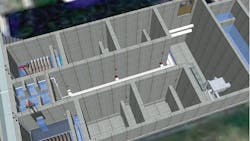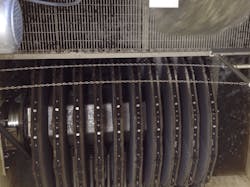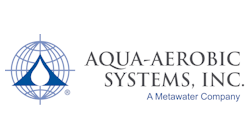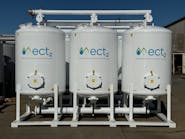The Portland, Ind., Wastewater Treatment Plant (WWTP) had been using six granular-media filter units for tertiary treatment since the 1980s. The plant’s treatment protocol included fine screens for grit removal, followed by primary clarifiers, trickling filters, aeration basins, secondary clarifiers, and the tertiary treatment system, followed by chlorine disinfection.
The main challenge facing the WWTP was that the tertiary media filters required too much maintenance and excessive backwashing. Besides problems with the 30 control valves, the plant had trouble with broken underdrains and with losing media.
“Not a day went by that we didn’t have to work on them, particularly on the control valves,” Plant Superintendent Robert Brelsford said. “The system required about 10,000 gallons per backwash.”
In the Fall of 2011, project engineers from Jones & Henry Engineers Ltd., of Fort Wayne, Ind., took a closer look at the six tertiary filters, which had a combined average flow of 2.35 million gallons per day (MGD).
“After a six-month evaluation, we determined that the old sand filters were not repairable,” Brian Houghton of Jones & Henry said. “Instead, the recommendation was to install two new cloth media disk filters, each with a capacity of 4.7 MGD.”
Finding Treatment Options
During the winter and spring of 2013, Brelsford, Houghton and Portland Mayor Randy Geesaman toured several municipal installations to evaluate treatment options. One location was the City of Bowling Green, Ohio’s water pollution control facility, which uses six AquaDisk® cloth media filters from Aqua-Aerobic to handle peak flows of up to 36 MGD.
“We went to Bowling Green a couple of times to look at the equipment,” noted Brelsford. “We were impressed.”
One of the critical issues they investigated was the choice between an outside-in design versus an inside-out design. Based on input from plant operators and maintenance personnel at the facilities sited, the outside-in configuration was chosen because it would be easier to clean.
“Our secondary clarifiers have a lot of moss,” said Brelsford, “which would get trapped and be hard to get out in an inside-out configuration.”
With the outside-in configuration of the AquaDisk filters, influent enters the filter unit and contacts the outside of the filter disk. Filtrate passes through the cloth media by gravity and is removed from the hollow area inside the filter disk through a hollow shaft that supports the individual disks. As solids accumulate on the surface of the media, the water level surrounding the disks rises.
Once it reaches a predetermined level, automatic backwashing begins: The disks rotate, then backwash shoes contact the media surface and a vacuum is applied to remove the solids. Filtration is not interrupted. Heavier solids settle to the bottom of the tank and are pumped to a digester.
A Fast-Tracked Design
Meanwhile, as the team was doing its field work and preparing to request proposals from disk-filter manufacturers, the Indiana Finance Authority informed the city that it could obtain funding for these wastewater plant improvements in the current state revolving funds (SRF)-project cycle, but bids for the project needed to be opened in approximately six weeks.
The city asked Jones & Henry if this schedule could be met. Jones & Henry said yes, and contacted Aqua-Aerobic Systems, which was able to fast-track the design and produce computer-aided design (CAD) drawings almost immediately to meet the deadline.
With a fast-track design-build process, the Portland Wastewater Treatment Plant went from design work to project completion in a little over 12 months. Meeting this very compressed timeline ensured that the plant would receive the SRF funding.
“Meeting that timeline was due in large part to the close coordination and communication between city personnel, the regulatory agency, the finance agency, the engineering firm (Jones & Henry) and equipment suppliers, especially Aqua-Aerobic,” said Houghton.
The tertiary treatment system was completely renovated, adding two AquaDisk filters, each comprised of 10 disks and capable of handling peak flows of up to 4.7 MGD (total treatment volume for both filters is 9.4 MGD). Each disk is fitted with OptiFiber® cloth filtration media designed to maximize solids removal over a wide range of particle sizes. Its thick, pile construction allows filtered solids to be stored, unlike microscreen media, thereby extending the time between back-washes. This uniquely designed cloth-fiber-backing support structure promotes thorough cleaning of the media for optimum performance.
The project also included pipe work (much of the existing piping was kept, rehabbed, and reconfigured), new controls, HVAC work, repainting, polishing the concrete floors, adding a new roof, and rehabbing the anaerobic digester used to treat clarifier sludge.
In operation, either one of the AquaDisk filters can handle the treatment capacity of the six previously used granular media filters, providing flexibility for routine maintenance and future growth.
Backwash volume has been reduced 97 percent, to about 300 gallons per backwash. Additionally, energy consumption has dropped dramatically because so much less water is pumped back through the system. WW
About the Author: Mark Hughes is a director of product management at Aqua-Aerobic Systems. He oversees all aspects of the company’s filtration product line and has been involved in the wastewater industry since 2008.
Published in WaterWorld magazine, December 2021.





